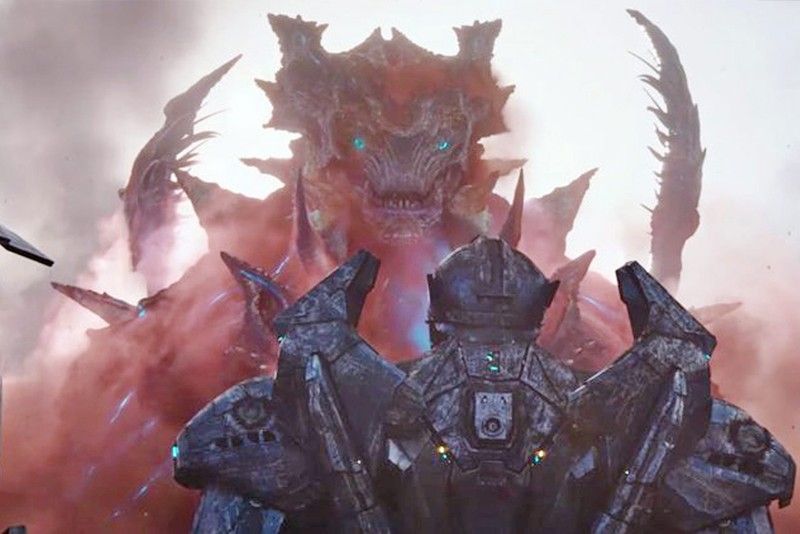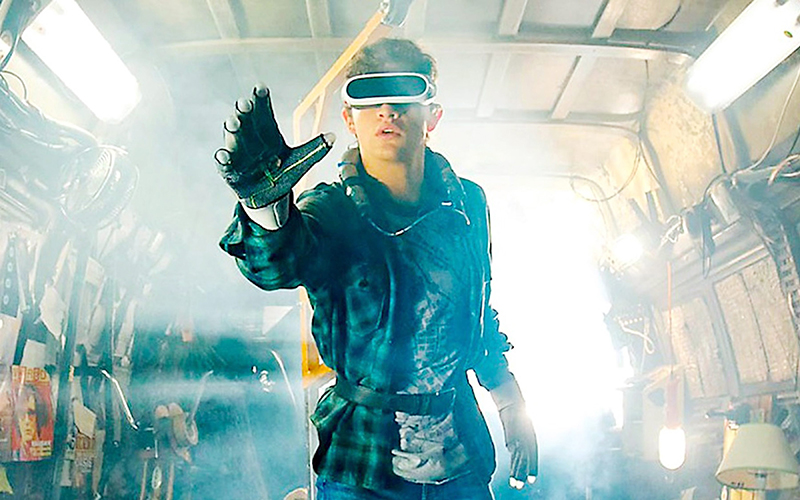Future-topias take us back to the past

What it all amounts to, is the spectacle of Spielberg simply playing with his vintage toy collection with a $175 million budget.
What kind of future do you see yourself in?
Two current movies — Pacific Rim 2 Uprising and Ready Player One — plunge us into dystopian tropes that rely as much on our nostalgia as they do our brave new world predictions.
Pacific Rim Uprising, a sequel to Guillermo Del Toro’s giant robot vs. giant monster entry from 2013, opens with John Boyega (Star Wars reboot sidekick hero) partying it up in an abandoned coastal mansion sometime in the future, years after the last round of kaiju — nasty, giant alien beasts that slipped into our world through an inter-dimensional “breach” — were eliminated. People are basically dancing on the skeletal corpses of giant monsters, thinking everything’s cool now. Boyega plays the son of fallen hero Stacker Pentecost (Idris Elba from the original, sadly absent here) but likes to point out “I’m not my father.” He’s a thief, basically, helping bad guys steal rusting jaegers — the manmade robots built to defeat kaiju — and sell them piece by piece on the black market.
He, along with a scrappy teen girl (Cailee Spaeny) who’s built her own pint-sized jaeger (Scrapper) to be ready when the nasty kaiju “come back,” get arrested and plopped into a jaeger-piloting training program. (The weird thing about this Pacific Rim future is there are very few pilots available from the entire globe, but they still seem to represent a perfect ethnically diverse mix; and, somehow with the sum total of man’s technology, capable of building kaiju-battling robots, they’ve only managed to amass… three workable robots.)
Making things sequelish are the presence of Charlie Day as Dr. Newt Geiszler, a scientist who’s mind-melded once too often with a kaiju, and his more stable-minded partner Dr. Herman Gottlieb (Burn Gorman) to even things out.
If you liked Pacific Rim (and I kinda did, though there were a lot of haters), you might find this sequel equally fun, particularly the robot vs. kaiju battles that take place on a grand scale — wiping out huge urban chunks of downtown Tokyo real estate in the process (which we’ve been assured were “evacuated to shelters” beforehand). Directed by Stephen S. DeKnight, there is something oddly nostalgic about skyscraper-sized creatures basically holding an IFC match in a public octagon: it reminds us of those old Godzilla movies versus King Kong, Ghidra, Rodan, Mothra and yes, Mechagodzilla.

Wade Watts (Tye Sheridan) gets unreal in Steven Spielberg’s Ready Player One.
And speaking of Mechagodzilla, the ‘80s nuts-and-bolts version of our favorite oversized Japanese lizard makes a brief appearance in Steven Spielberg’s futuristic Ready Player One, based on the bestselling novel about a virtual reality game called the OASIS, invented by the world’s first “trillionaire,” the late James Halliday (Mark Rylance), and which is now played by most everybody on the planet. Young Wade Watts (Tye Sheridan) tries to win Halliday’s final videotaped challenge online: uncover three “Easter eggs,” color-coded keys in his virtual maze, and gain control of Innovative Online Industries Enterprises, which operates OASIS with Gestapo-like tactics (drones, goon squads and the like).
Wade — or Parzival, as his online avatar is called — lives in a heap of stacked trailers in dystopian Columbus, Ohio, 2045 (many years after the Trump Administration), where down-and-out families strive to escape their wretched reality by playing video games. Wade, along with an avatar pal named Art3mis (Olivia Cooke), seek clues in Halliday’s meticulously-preserved life story to locate the three elusive keys and overcome the corporate control of IOI CEO Noah Sorrento (Ben Mendelsohn) while gaining the gentle benediction of Halliday’s genial avatar guru.
So far, so Willy Wonka, so Hunger Games. But Spielberg’s real purpose here is not so much to explore Gen-Z’s psyche and appetites, as it is to trot out his own generation’s ’80s fixation. References ricochet around, some fleeting — like Joy Division T-shirts, Battlestar Galactica plastic models, Chucky dolls and Say Anything boomboxes — to running gags (the Back to the Future DeLorean car Parzival drives in the OASIS, or the “Zemeckis Cube,” which has a secret power that ties in with the aforementioned ’80s movie). Some of these gags are fun to watch, or recognize, streaming by in the avatar world. The Iron Giant cuts a fine figure in this post-economic crash environment, as does Mechagodzilla, fired up by Sorrento and his would-be evil partner I-ROk (Silicon Valley’s T.J. Miller) to clear Parzival from the scoreboard.
What strikes this viewer is how people will go to such great lengths to construct a virtual reality that’s every bit as hyperviolent, overstimulated and problem-ridden as the actual world they’re trying to leave behind. Why even bother? Well, you can look however you want in the OASIS, for one thing. But the whole grid is constructed like some annoying, ADHD-overload video game with ’80s neon graphics, which makes perfect sense to gamers but might challenge those born before, say, The Shining was released in 1980 or who may miss fleeting references to Monty Python’s “Holy Hand Grenade.” (Though who knows, with a new generation brought up on nostalgia-driven Spamalot?) You can see Spielberg ticking off a list of things he just has to throw into this dizzying virtual stew — references to John Hughes movies, Centipede, PacMan, Beetlejuice, a few beats of Jurassic Park, even an extended sequence inside The Shining’s Overlook Hotel, containing predictable video game challenges tied to iconic scenes. It mostly just makes you want to watch the original Kubrick film again.
Spielberg is a product of the ‘70s, of course, but his biggest hits were in the ‘80s, and it makes sense that he wants to riff on the golden era of nostalgia that Stranger Things recently tapped into. So let the gold coins of nostalgia shower down!
There definitely was an opening here for Spielberg to explore real modern teen issues such as the increasing anonymity of the online world — where people’s true identities are hidden, so they might be an attractive female avatar in the OASIS, but in the real world, they’re really a 400-pound male gamer fanboy sitting on his bed somewhere in Ohio; or they might even be Russian bots convincing Facebook users not to vote for Hillary Clinton. But such subtle inquiries are clearly outside the scope or interest of this film.
What it all amounts to, after the whizz-bang of constructing a meticulous virtual reality with some of the fakest, retro-looking avatars ever, is the spectacle of Spielberg simply playing with his vintage toy collection with a $175 million budget, apparently believing we are having as much fun as he is.
Face it: the future has never looked so much like the past. Question is, are you game?















